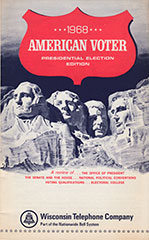 |
 |
 |
 |
 |
 |
 |
| 1989 | 1900 | 1921 | 1939 | 1953 | 1964 | 1969 |
Click on the above logos to get a larger image and to access the logos page.


A website created as a memorial to the people, history, technology and the “Spirit of Service” of what was known as the “Bell System” prior to 1984.



Alexander Graham Bell (March 3, 1847 - August 2, 1922)
Read the 100th Anniversary booklet published by AT&T in 1947, dedicated to Mr. Bell and his remarkable legacy.
An inspiring article on Alexander Graham Bell that is sure to bring a tear to your eye. This man had great vision, and unlike today’s tech giants, he was very humble, and was not out for personal glory or earthly riches. Sadly, Mr. Bell is no longer taught in school, or paid the respect he deserves.
AlexanderGraham Bell, Digital Nomad
“Founder, former president and senior trustee of the National Geographic Society,”
Original article at National Geographic
Telephones Were Silenced for One Minute After Alexander Graham Bell Died on August 2, 1922
By the time Bell died, he had moved on to other inventions.
But the telephone made a huge mark on American society
Smithsonian article about the silence.
“When we think of the telephone and its inventor we likely think of Alexander Graham Bell. On March 10, 1876, at the age of 29, Bell spoke to his fellow worker Watson positioned in another room, uttering the famous words over the new device that would change the world: “Mr. Watson—Come here—I want to see you.”
http://www.tomorrowsworld.org/magazines/2016/november-december/the-man-who-worked-with-all-his-might
Mr. Bell
In 1947, the Bell System honored the 100th anniversary of Alexander Graham Bell’s birth with a long (for a Bell System film) biopic. The half-hour film starred Raymond Edward Johnson as Bell and Mason Adams as Thomas A. Watson. The film reenacts Bell’s daily life during the period in which he invented the telephone — the mid-1870s.

View Some Of Our History
Here is a snapshot of the USA Hot Links page on the WayBack Machine that was refferring to our site way back when.
USA Today took down the page (along with all their Hot Sites content) sometime after 2018, give or take.

1968 American Voter
An interesting booklet reproduced by Wisconsin Telephone Company for the 1968 U.S. Federal election. This booklet details The Office of The President, The Senate and House, Electoral College, and that it is important for every legal, and qualified citizen to vote, and not ignore their solemn duty. Americans have fought and died so that legal citizens of our great nation can vote.
In no time in our history is it more imperative than now, that we as legal U.S. citizens vote for the candidates that will stand for Life, Liberty, Freedom, and the Rule of Law, and not lawlessness. In one election we could loose it all.
THE LEAST WE CAN DO IS VOTE!
Support This Site
Please consider making a donation using the links below. All proceeds will be applied towards the maintenance and aquisition of new material for this site.

Interesting Facts and Historical Background on the Bell System

We Offer Personalized One-On-One Service!
Call Us Today at (651) 787-DIAL (3425)

Bottom line is… If we don’t have it, we’ll find it!

References
Click on the bell logo on the left to start you research based on what you are interested in.

With White & Yellow Pages, Maps & Directions, People and Business Search…
Bell System Directories Offer The Most Comprehensive Search Directory on The Internet, and With International listings!

Formerly…
Structured cabling solutions for all business, telecom providers, construction companies, multi-dwelling units (condominiums, apartments), and single family homes.
Systimax offers the most comprehensive and reliable line of cabling, and voice, video and data information outlet products that are manufactured in the United States.

AT&T Mobility Tower Strategy Portal - Tower Operations
Verizon Wireless Network Real Estate Inquiries Portal - Tower Operations

The End of an Era - A New Beginning (December 31, 1983)
“The Bell System as we have known it will exist only in our memories and in the history books.”

The Bell System provided what was by all accounts the best telephone service in the world. Could the year 2004 mark the beginning of a NEW BELL SYSTEM? Charlie Stanley, an AT&T employee who was born in the year the Bell System died, created a hoax web page of what he envisions as a new Bell System. To see his creation, click HERE. Thanks Charlie for your addition to this website!

Many years before the US Government destroyed the Bell System there was a " Plot to Bury the Bell System”. Of course the advertisement was about burying cable and not about a plot on the part of the US Government to “bury” the Bell System! But one wonders if there was some double-meaning intended in that ad?


















